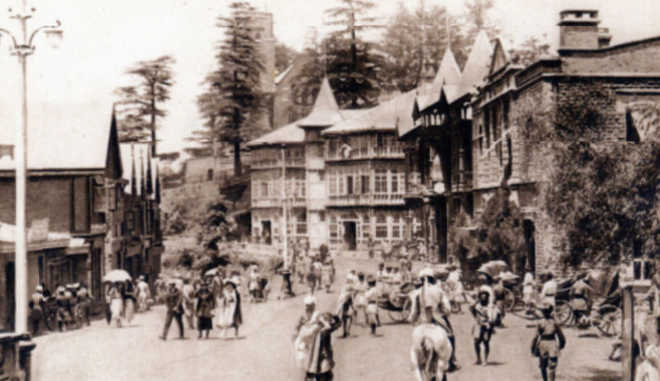
Scandal Point in the 1920s
Raaja Bhasin
Of the uncountable rumours to come out Shimla, perhaps none is as embedded or widely circulated as that of Scandal Point. For decades, the informed, the wise and the well-read have passed on the word of what they had ‘read somewhere or had been told by someone’. In my own time, I had asked several of where they had read this or by whom had they been told. The answers were vague to say the least. Expectedly, the word of ‘the someone and somewhere’, passed under a cloud of doubt.
Going by the popular tale, recounted time and again with authority, a Maharaja of Patiala carried off a British Viceroy’s daughter (or wife), from this spot on The Mall. The Maharaja in question may have had numerous affairs and kept a substantial harem, but at the time of the supposed incident, he wasn’t born and if he was, then he would have been an infant. Years ago, as now, little or large gatherings have sorted out the world at this crossroad and exchanged gossip. Within the course of a conversation, governments had risen and fallen on Scandal Point; who ran off with whom and who would like to run off with whom had been hotly debated. In a word: scandal; and, probably, hence the name. Seen with simple logic, a leading Indian prince would hardly parade the streets for his love affairs and that too with the daughter of the British Viceroy of India, the most powerful man in the country.
The Patiala connection probably stems from the fact that the Patiala durbar had a ‘Vakil khaana’ in the Middle Bazaar, just below the so-called Scandal Point. Here, employees of the Patiala durbar worked and conducted the sundry matters of this influential princely state. In 1929, 10 disgruntled citizens of Patiala drew up a list of charges against the Maharaja and a subsequent inquiry led to a fairly strong condemnation of his. However, another investigation conducted at the behest of the Viceroy, Lord Willingdon, cleared the Maharaja of all charges.
Employees of the ‘Vakil khaana’, like many others, would probably sun themselves and air their views to anyone and all who cared to listen, which would have included the matter just mentioned.
Historian Pamela Kanwar notes: “...people tend to believe rumour more than official reports; rumour satisfies the need for mystery and the belief that truth is always hidden. The Patiala ruler remained, to popular satisfaction, a notorious figure in Simla”.
The place name, Scandal Point, appeared in print only in a couple of places before 1947, but seems to have gathered steam in the 1950s when the myth was passed to the realm of reality.
Carrying on in a similar vein, another popular myth of the years before Independence is that Indians were not permitted on The Mall and that signs with the words: “Dogs and Indians not Allowed” were pasted all over the place. The reality is substantially different, as several of The Mall’s establishments were owned by Indians and almost all had Indian staff. Any number of pictures will show a large number of Indians on The Mall. This myth probably has its origin in the municipal law that prohibited porters looking for custom on The Mall. The interpretation of this law encompassed ‘ill-clad’ people who were khadi -clad freedom-fighters.
The strangest one of all these ‘truths’ is that of ‘Ram Tel’ and the supposed tortures conducted by Indian policemen at the behest of their British masters. Going by what is still talked about by some older residents of Shimla, any Indian walking around after dark would be seized by the police. His head would be shaved, his skull punctured and the so-called hapless being would be hung upside down in order to allow the brain fluid, ‘Ram Tel’, to drain into a vessel kept for the purpose. This liquid was supposedly carted off to assorted war fronts to treat the wounded. The explanation is somewhat simpler. Loiterers after dark could be questioned and could well be ordered by the policemen patrolling the streets, ‘Bhag ja, nahi to ulta tang doonga’ (Get lost or I’ll hang you upside down).
The tale of ‘Ram Tel’
- The place name, Scandal Point, appeared in print only in a couple of places before 1947, but seems to have gathered steam in the 1950s.
- The strangest of all myths about Scandal Point is that of ‘Ram Tel’ and the supposed tortures conducted by Indian policemen at the behest of their British masters. Going by what is still talked about by some older residents of Shimla, any Indian walking around after dark would be seized by the police. His head would be shaved, his skull punctured and hung upside down in order to allow the brain fluid, ‘Ram Tel’, to drain into a vessel kept for the purpose. This liquid was supposedly carted off to assorted war fronts to treat the wounded.
(The writer is an author, historian and journalist)



























